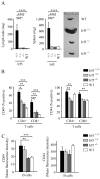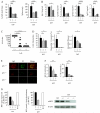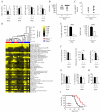IFN regulatory factor 5 is required for disease development in the FcgammaRIIB-/-Yaa and FcgammaRIIB-/- mouse models of systemic lupus erythematosus
- PMID: 20007534
- PMCID: PMC2858062
- DOI: 10.4049/jimmunol.0901748
IFN regulatory factor 5 is required for disease development in the FcgammaRIIB-/-Yaa and FcgammaRIIB-/- mouse models of systemic lupus erythematosus
Abstract
Polymorphisms in the transcription factor IFN regulatory factor 5 (IRF5) are strongly associated in human genetic studies with an increased risk of developing the autoimmune disease systemic lupus erythematosus. However, the biological role of IRF5 in lupus pathogenesis has not previously been tested in an animal model. In this study, we show that IRF5 is absolutely required for disease development in the FcgammaRIIB(-/-)Yaa and FcgammaRIIB(-/-) lupus models. In contrast to IRF5-sufficient FcgammaRIIB(-/-)Yaa mice, IRF5-deficient FcgammaRIIB(-/-)Yaa mice do not develop lupus manifestations and have a phenotype comparable to wild-type mice. Strikingly, full expression of IRF5 is required for the development of autoimmunity, as IRF5 heterozygotes had dramatically reduced disease. One effect of IRF5 is to induce the production of the type I IFN, IFN-alpha, a cytokine implicated in lupus pathogenesis. To address the mechanism by which IRF5 promotes disease, we evaluated FcgammaRIIB(-/-)Yaa mice lacking the type I IFN receptor subunit 1. Unlike the IRF5-deficient and IRF5-heterozygous FcgammaRIIB(-/-)Yaa mice, type I IFN receptor subunit 1-deficient FcgammaRIIB(-/-)Yaa mice maintained a substantial level of residual disease. Furthermore, in FcgammaRIIB(-/-) mice lacking Yaa, IRF5-deficiency also markedly reduced disease manifestations, indicating that the beneficial effects of IRF5 deficiency in FcgammaRIIB(-/-)Yaa mice are not due only to inhibition of the enhanced TLR7 signaling associated with the Yaa mutation. Overall, we demonstrate that IRF5 plays an essential role in lupus pathogenesis in murine models and that this is mediated through pathways beyond that of type I IFN production.
Figures






Similar articles
-
Genetic Reduction of IRF5 Expression after Disease Initiation Reduces Disease in a Mouse Lupus Model by Impacting Systemic and End-Organ Pathogenic Pathways.J Immunol. 2023 Nov 1;211(9):1308-1319. doi: 10.4049/jimmunol.2300298. J Immunol. 2023. PMID: 37721418 Free PMC article.
-
Phenotype conversion from rheumatoid arthritis to systemic lupus erythematosus by introduction of Yaa mutation into FcγRIIB-deficient C57BL/6 mice.Eur J Immunol. 2013 Mar;43(3):770-8. doi: 10.1002/eji.201243057. Epub 2013 Jan 25. Eur J Immunol. 2013. PMID: 23280344
-
Unique primed status of microglia under the systemic autoimmune condition of lupus-prone mice.Arthritis Res Ther. 2019 Dec 30;21(1):303. doi: 10.1186/s13075-019-2067-8. Arthritis Res Ther. 2019. PMID: 31888754 Free PMC article.
-
Interferon regulatory factor 5 in the pathogenesis of systemic lupus erythematosus.Clin Dev Immunol. 2012;2012:780436. doi: 10.1155/2012/780436. Epub 2012 Nov 1. Clin Dev Immunol. 2012. PMID: 23251221 Free PMC article. Review.
-
Interferon regulatory factors in human lupus pathogenesis.Transl Res. 2011 Jun;157(6):326-31. doi: 10.1016/j.trsl.2011.01.006. Epub 2011 Feb 8. Transl Res. 2011. PMID: 21575916 Free PMC article. Review.
Cited by
-
Brief Report: IRF5 systemic lupus erythematosus risk haplotype is associated with asymptomatic serologic autoimmunity and progression to clinical autoimmunity in mothers of children with neonatal lupus.Arthritis Rheum. 2012 Oct;64(10):3383-7. doi: 10.1002/art.34571. Arthritis Rheum. 2012. PMID: 22674082 Free PMC article.
-
Role of type I interferons in the activation of autoreactive B cells.Immunol Cell Biol. 2012 May;90(5):498-504. doi: 10.1038/icb.2012.10. Epub 2012 Mar 20. Immunol Cell Biol. 2012. PMID: 22430248 Free PMC article. Review.
-
Type II but Not Type I IFN Signaling Is Indispensable for TLR7-Promoted Development of Autoreactive B Cells and Systemic Autoimmunity.J Immunol. 2020 Feb 15;204(4):796-809. doi: 10.4049/jimmunol.1901175. Epub 2020 Jan 3. J Immunol. 2020. PMID: 31900342 Free PMC article.
-
A phospho-tyrosine-based signaling module using SPOP, CSK, and LYN controls TLR-induced IRF activity.Sci Adv. 2022 Jul 8;8(27):eabq0084. doi: 10.1126/sciadv.abq0084. Epub 2022 Jul 8. Sci Adv. 2022. PMID: 35857476 Free PMC article.
-
Lupus nephritis progression in FcγRIIB-/-yaa mice is associated with early development of glomerular electron dense deposits and loss of renal DNase I in severe disease.PLoS One. 2017 Nov 30;12(11):e0188863. doi: 10.1371/journal.pone.0188863. eCollection 2017. PLoS One. 2017. PMID: 29190833 Free PMC article.
References
-
- Rhodes B, Vyse TJ. The genetics of SLE: an update in the light of genome-wide association studies. Rheumatology (Oxford) 2008;47:1603–1611. - PubMed
-
- Simard JF, Costenbader KH. What can epidemiology tell us about systemic lupus erythematosus? Int J Clin Pract. 2007;61:1170–1180. - PubMed
-
- Rahman A, Isenberg DA. Systemic lupus erythematosus. N Engl J Med. 2008;358:929–939. - PubMed
-
- Lauwerys BR, Wakeland EK. Genetics of lupus nephritis. Lupus. 2005;14:2–12. - PubMed
Publication types
MeSH terms
Substances
Associated data
- Actions
Grants and funding
- AR050942-04/AR/NIAMS NIH HHS/United States
- T32 DK007053/DK/NIDDK NIH HHS/United States
- N01 HV028183/HV/NHLBI NIH HHS/United States
- DK07053/DK/NIDDK NIH HHS/United States
- N01-HV-28183/HV/NHLBI NIH HHS/United States
- R01 AR35230/AR/NIAMS NIH HHS/United States
- P01 AR050256/AR/NIAMS NIH HHS/United States
- AI07290-23/AI/NIAID NIH HHS/United States
- T32 AI007290/AI/NIAID NIH HHS/United States
- R01 AR035230/AR/NIAMS NIH HHS/United States
- T32 AR050942/AR/NIAMS NIH HHS/United States
- N01 HV028183/HL/NHLBI NIH HHS/United States
LinkOut - more resources
Full Text Sources
Medical
Molecular Biology Databases

